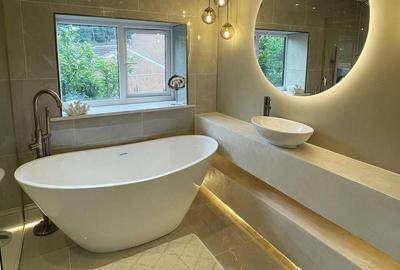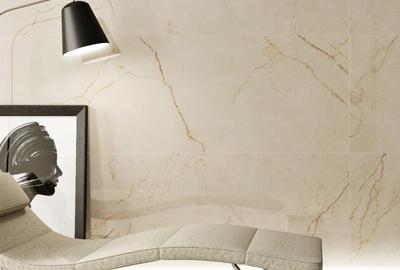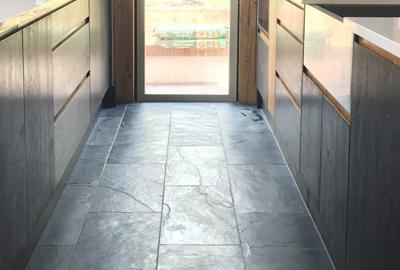As a place of relaxation and sanctuary, there’s something about a clean bathroom that makes you feel a bit more put together whilst we’re trying to keep up with our busy lifestyles. Whether you’re wanting to maintain the luxurious feel of a brand new bathroom or trying to give your old bathroom a new lease of life, it's important to know the best practices on how to properly clean and maintain your bathroom tiles. So, let us indulge you with some of the best tips on how to do just that!
Importance of Regular Cleaning and Maintenance for Bathroom Tiles
Hygiene
The first most important reason as to why regular cleaning of your bathroom tiles is necessary is due to hygiene. By default, this space is a damp and moist area of your home, making it more subjective to mould, limescale and bacteria. As a space you come to unwind, practise self-care and clean yourself, the last thing you want to do is bathe or shower in a dirty and potentially harmful environment.
Longevity and Damage Prevention
We know bathroom renovations are not at all cheap (especially in this current climate!) and for those who are fortunate to have a modern or a brand new luxurious bathroom, it is wise to invest time into your investment with regular cleaning of your bathroom tiles to ensure they look as good as the day they were installed. This is to also prevent any future build up of mould or limescale which could damage your bathroom fixtures when neglected and make your tiles look unsightly.
Drab to Fab
We’re constantly looking at ways to keep our house projects as cost-effective with very minimal external help as possible. You could replace old bathroom tiles if you are good at DIY, however this still isn't the cheapest option. No matter how old and grubby they look, with the correct cleaning materials, proper care and regular maintenance, you can really give this space a new lease of life!
Best Practices for Maintaining Bathroom Tiles
Polished Porcelain Wall and Floor Tiles
Polished porcelain tiles can be used on the wall as well as floors in bathrooms, however it is advised to use a bath mat when you are leaving the shower or bath, to ensure you avioid any slips.
As porcelain is a non-porous material, water will simply sit on top of the tiles, until it is either wiped away or evaporates. However, standing water can penentrate through grout, especially in shower areas, which can result in lifting of the tiles or damaging your substrate, as well as a build-up of mould and mildew. We recommend using waterproof backer boards and waterproof jointing tape in a shower areas to ensure your substrate is waterproof and also use a grout protector to ensure your grout keeps looking like new and doesn't get stained.
Here are the basic steps in which we recommend to make your polished porcelain bathroom tiles appear brand new again:
- For general upkeep, we would recommend cleaning with a neutral tile cleaner such as Waxwash Neutral Tile Cleaner or Porcelain Tile Cleaner.
- For prevention of grout mould, mildew and staining, we recommend sealing with an LTP Grout & Tile Protector. It's an impregnating sealer that you apply to the grout once you've installed the tiles or after you've cleaned them down.
- If you're looking to refurbish your tiles and grout, you can use an intensive cleaner such as LTP’s Grimex Intensive Cleaner. Effective for removing stubborn stains, ingrained dirt, oil and grease, it also strips the tiles of existing sealant.
- Using LTP’s MPG Polished Wall and Floor Sealer, you can re-seal your bathroom wall and floor tiles. We recommend following LTP’s Technical Data Sheet for directions of use.
Shower and Splashback Wall Tiles
Due to being subjected and exposed to more prolonged periods of water, keeping your shower area dry after use is a great maintenance tip in prevention of mould, mildew and potential tile damage, and also a free one! This is also a recommended practice to ensure the tiles are free from watermarks, leaving the tiles looking as good as the day they were installed. Just simply use a rubber shower squeegee like this sold by John Lewis to remove access water.
We know cleaning your grout lines can be a bit of a tedious job (ok, a massively tedious job!), sealing your grout with Grout & Tile Protector is highly recommended in either your shower or splashback areas as it is more prone to lime scale and mould as a result of heat and moisture coming from the hot water. This not only provides longevity to the grout itself, but it also acts as a protectant from water absorption that could damage your tiles.
Matt Porcelain Bathroom Wall and Floor Tiles
Matt porcelain tiles are most popular in bathrooms due to the assurance they can provide underfoot, making it a little safer for young children. Not only are they more practical, their surface also shows up far less dirt and marks in comparison to that of a shiny/polished surface; less maintenance for those of us who are constantly on the go! Nevertheless, despite their ability to hide dirt, they are a little tougher to clean to that of a gloss or polished surface which is easily wipe-able.
At least once a week, we would recommend cleaning with a neutral tile cleaner such as Waxwash Neutral Tile Cleaner or Porcelain Tile Cleaner. A damp sponge or cloth can be used to rub in the cleaning solution and for tougher marks, we would recommend a soft bristle brush.
For more extreme cases of grime, stains or even for restoration of old tiles you are trying to bring back to life, we would recommend using a more intensive cleaner such as Grimex Intensive cleaner.
Natural Stone Bathroom Floor Tiles
Natural stone tiles are perfect for the bathroom however, they do require a little maintenance just after the installation process, not only to preserve the stone, but to ensure they will continue to look fantastic. With general upkeep and care, your natural stone floor tiles can last a lifetime.
Using either Mattstone Natural Stone Impregnating Sealer or Colour intensifier & Stainblock Natural Stone Sealer, this sealer absorbs into the surface of the tile and acts as a barrier against dirt, grime, oil and grease. Using a sealer on your stone tiles is also a great hack to enhance the natural colouring on your natural stone floor tiles, especially if you are trying to revive some existing natural stone bathroom floor tiles.
Another essential aspect of maintaining your natural stone tiles is to avoid using excessive water when cleaning to avoid absorption that can lead to stains and discolouration. When cleaning your tiles, we advise the following steps:
- Wipe and loose dirt or debris away with a soft cloth
- Fill a bucket with warm water, adding 2 or 3 capfuls of a neutral tile cleaner (nothing too abrasive)
- Using a mop, clean the tiles in small sections at a time, wringing it frequently to avoid spreading dirt and grime about
- Once mopped, go over the tiles with just warm water with your mop to remove any remaining cleaner
- Lastly, dry your tiles with a clean microfibre cloth or towel.
The use of bathmats on top of your natural stone floor tiles outside either your shower or bath area is also a great way to prevent water from sitting on top of the tiles, lessening the need to either dry the area down and to preserve the sealer on the tiles in this area.
Tip for Removing Tough Stains and Grime from Bathroom Tiles
We cannot stress enough how important it is to use the appropriate cleaning solutions for your bathroom wall and floor tiles. This is to not only promote longevity, but to also prevent damaging your tiles.
Whether you are trying to restore the life of old, existing bathroom tiles, or have come across a tough stain that your usual neutral tile cleaner cannot remove, do not panic and use harsh chemicals such as bleach or anything with high acidity. This can cause irreversible damage to your bathroom floor tiles such as discolouration.
For tough stains and grime, we would advise using the heavy duty intensive cleaner, Grimex. This product is suitable for Travertine, Limestone, Sandstone, Slate, Marble, Porcelain, Granite, Terracotta, Quarry tiles, Brick and Paving.
Mild Cases and on Absorbent Tiles
- Dilute 1 part of solution with 10 parts warm water. Apply with a cloth or with a mop then wipe off thoroughly with a clean damp cloth.
More Severe Cases
- Dilute 1 part solution in 3 parts warm water. Apply liberally, spreading over the surface of the tiles with a mope or cloth. If necessary, you may need to agitate with a medium bristle brush and leave for 5-10 minutes to react. Agitate surface again and then mop up and rinse thoroughly with clean water.
In Extremely Severe Cases
- Use undiluted and agitate with scrubbing brush or mechanical scrubber if necessary. Neutralise treated surface with clean water after use.
Please note that your polished porcelain tiles or natural stone tiles will need re-sealing after using this solution.
Tools and Materials Needed for Cleaning Bathroom Tiles
- Vacuum or sweeping brush
- Bucket of hot water
- Dust mop
- Soft bristle brush (for grout lines)
- Clean towel or Microfibre cloth
- Cheese Cloth
- Neutral tile cleaner: Waxwash Neutral Tile Cleaner or Porcelain Tile Cleaner
- Clean fresh water
- Vacuum or sweeping brush
- Bucket of hot water
- Dust mop
- Soft bristle brush
- Clean towel or Microfibre cloth
- Neutral tile cleaner: Waxwash Neutral Tile Cleaner or Porcelain Tile Cleaner
- Clean fresh water
- Sweeping brush
- Bucket of hot water
- Dust mop
- Soft bristle brush
- Neutral tile cleaner: Waxwash Neutral Tile Cleaner or Floorshine Neutral Tile Cleaner
- Clean towel
- Clean fresh water

















